Visiting Angkor Wat – What You Need to Know
Angkor Wat is probably, one of the most famous tourist destinations in the whole of Asia and the biggest highlight of Cambodia (it’s even in the national flag), so visiting Angkor Wat is on the bucket list for many travelers. This post highlights everything you need to know to plan your visit to Angkor Wat hustle free.
What creates a challenge is not knowing how to plan your visit to Angkor Wat as millions of tourists come to this ancient city of the Khmer Kingdom every year and gets VERY crowded, how to survive the scorching heat of Cambodia, and how to explore the most iconic temples without a tour guide.
This UNESCO World Heritage Site in Siem Reap, a resort town in northwestern Cambodia, spans on 400 sq. km of land and comprises of around 100 temples. So trust me, visiting Angkor Wat without a good plan is a baffling task. That’s why I created this ultimate guide where I give all the tried and tested information you’ll need to know.
However, before going into the details of visiting Angkor Wat as peaceful and organized as it can be, it’s important to touch on the basic history of these magnificent temples. Also, here’s a guide to the things to do in Siem Reap besides temples.
A short history lesson of Angkor
Angkor is a temple complex built at the beginning of the 12th century as a Hindu temple dedicated to Vishnu for the Khmer Empire. Gradually, it transformed into a Buddhist temple in the same century and served as a capital of the Empire and a state temple of King Suryavarman II.
Angkor Wat is the central, iconic, and the most famous temple of the Angkor wat Archeological Park. It is the largest religious monument in the world and the best-preserved site in the whole park. However, since the 19th century, it’s not a practicing religious site anymore.

The name translates into ‘the city of temples’ and when UNESCO added it to its World Heritage Site list in 1992, the number of tourists sky-rocketed from thousands to millions. Additionally, being one of the filming locations for a Hollywood movie Lara Croft: Tomb Raider starring Angelina Jolie also played a big part in its fame.
Therefore, Angkor Wat Archeological Park is the primary source of income for the whole country.
Things to know before visiting Angkor Wat
Best time to visit Angkor Wat
The temples are the all-year-round destination. The low season here is from June to October which is a monsoon season and brings fewer crowds. November to March is the high season with lots of tourists and cooler days.
The best balance between the weather and crowds is from late November to early December, or late February to March.
If possible avoid April and May, considered as the hottest months of the year. However, there are smaller crowds and a Khmer New Year in mid-April.

Safety while visiting Angkor Wat
In general, Cambodia is a safe country to travel to. The most typical crime here is petty theft, including pickpocketing and bag snatching. Like anywhere in the world, it’s better to be cautious of your surroundings and keep your belongings close to you, especially when riding in tuk-tuks. There have been incidents when passing motorbikes snatched bags from tuk-tuks.
Also, be aware of monkeys as they also tend to grab your food bag when least expected!
Angkor Wat entrance fee and opening hours
All the foreigners need to purchase a ticket which enables you to visit all of the temples of the Angkor Archeological Park except Phnom Kulen and Beng Mealea. There are additional tickets for this last two. Angor Wat entrance fee is determined by day passes, whose prices increase since 2017. Here are the three types of tickets available at the moment:
| Day Passes | Price | Validity | |
| One-day | $37 | the day of purchase | |
| Three-day | $62 | 10 days from the purchase date | |
| Seven-day | $72 | one month from the purchase date |
You MUST purchase tickets at the official ticket office 5 km away from Angkor Wat. If you purchase elsewhere, it won’t be valid. You can pay cash or via credit card.
Each ticket will have your photo taken right at the spot upon the purchase. Cover your shoulders and knees when buying the tickets, otherwise, they might refuse to sell it to you.
The office is open every day from 5 a.m – 5 p.m.
- Purchase your one-day pass before 5 p.m.
- If you buy it after 5 p.m it will be valid for the next day.
Opening hours for the temples:
- Angkor Wat Temple and Srassrang: 5 a.m – 5:30 p.m
- Phnom Bakheng and Pre Rup Temple: 5 a.m – 7 p.m
- Other temples: 7:30 a.m – 5:30 p.m
Note that the ticket line can be VERY long, especially for the one-day pass, so come here as early as possible, or after 5 p.m and buy it for the next day.
Just in case, check Angkor Enterprise for the most recent information on opening hours and changes to the Angkor Wat entrance fee.

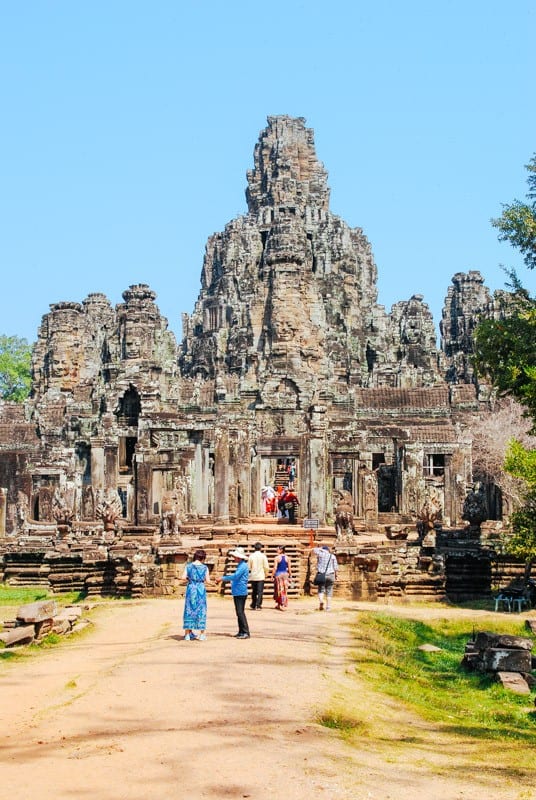
Dress code at Angkor Wat
In recent years, the dress code to explore Angkor Wat and other temples have been strictly enforced due to the multiple cases of nude photography.
It is a religious, sacred site that Cambodians are very proud of, therefore, if you don’t adhere to the dressing etiquette, you might be refused to enter.
Do not wear (applicable for both men and women):
- shorts and skirts above the knee
- Tank tops or anything revealing bare shoulders
Wear:
- light, breathable clothes
- comfortable shoes as you’ll be walking a lot
Compared to other temples in Asia, you don’t need to take your shoes off when visiting Angkor Wat or other sites within the territory.
What to bring when visiting Angkor Wat
- Tickets
- Fully charged camera
- Sunscreen and insect repellent
- Hat
- Sunglasses
- Water
- Snacks or lunch (locals do sell them at the temples but are more expensive than in the city)
- Cash (just in case)

How to get to Angkor Wat from Siem Reap
The best way to get to Angor Wat is to hire a tuk-tuk and the receptionist of your hotel or hostel can help you with that.
If you book Angkor Wat tour with an agency, it’s more likely that transportation from your hotel will be included.
In case you want to explore it on your own, rent a bike or a scooter for a day and cycle around.
Visiting Angkor Wat with a tuk-tuk
Most of the hotels and hostels do offer various tuk-tuk tours of Angkor Wat temples at a different price range. During the tour, the driver waits for you at the temples giving you enough time and space to explore at your own pace. Moreover, you won’t be walking a lot, as most of the temples are within several kilometers away from each other.
This is how we explored the temples and I think they are one of the best options to visit the most iconic temples of Angkor in a day.

Prices of those tuk-tuk tours are consistent anywhere, however, if you’d take several tours you might try to negotiate the price. Also, do note that Angkor Wat sunrise and sunset tours do cost extra.
Here’s the list of general prices:
- Small Circuit (half-day tour): $15-18
- Grand Circuit (full-day tour of outer temples): $20-30
- Sunrise/sunset – $10-15
If you want to join the orginized tour when visiting Angkor Wat, I recommend the following tours:
- Full-day small-group temples tour with a maximum of 10 people
- Full-day temple-hopping with a sunset that lasts around 10 hours
- Angkor Wat full-day tour with the sunrise with a maximum of 10 people per group
- Private sunrise bike tour from Siem Reap for adventurous souls
Angkor Wat temple guide – visiting iconic temples
Angkor Wat
As I mentioned above, Angkor Wat is the central piece of the complex. Often referred to as the seventh wonder of the world, it took 30 years to complete with the aim to be an eventual mausoleum of the King, besides being the capital and the state temple.

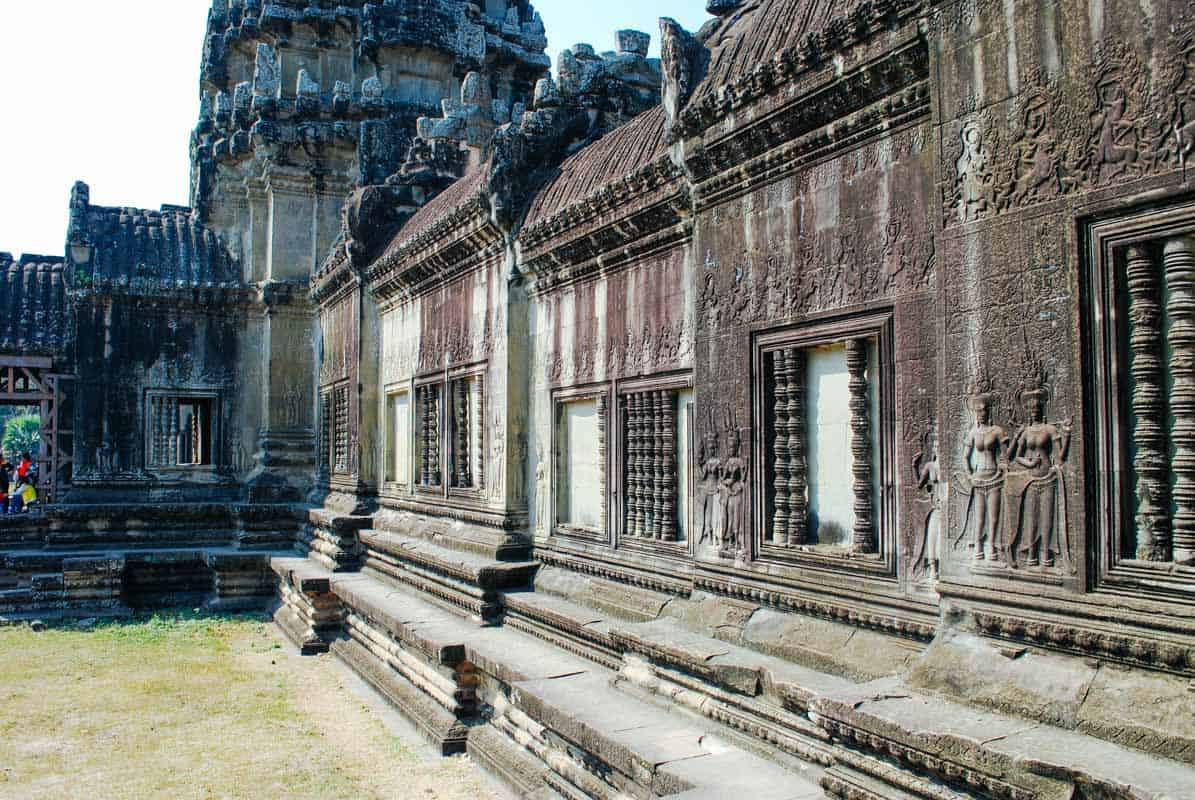
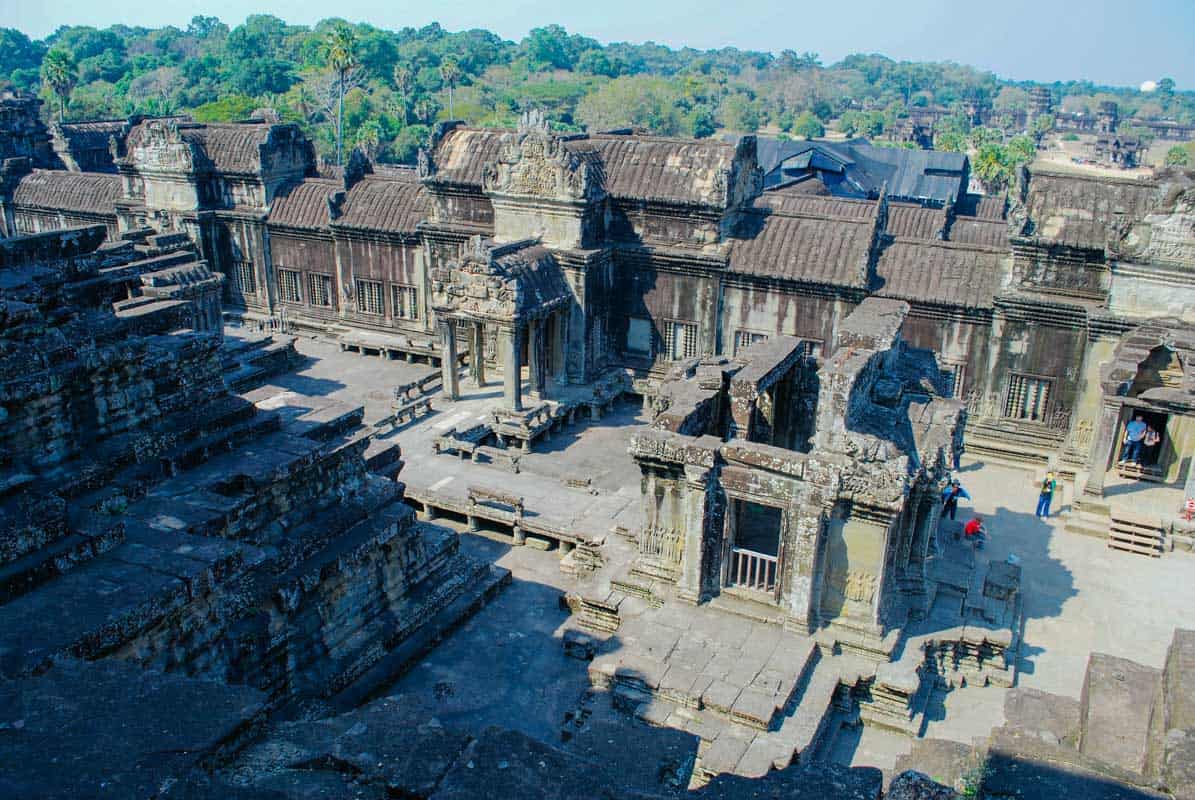
Spend at least two hours exploring astonishingly detailed carvings and jaw-dropping complex architectural design.
Angkor Thom Complex
Translated as the ‘great city’ Angkor Thom, situated 3 km away from Angkor Wat, was the latest and most surviving capital city of the Khmer empire, built in the late 12th century by King Jayavarman VII.
Covering the area of 9 sq. km, Angkor Thom is another complex featuring several monuments of various eras.
The King’s state temple, Bayon, sits right in the center of the city with other significant sites gathered around the square.
The Bayon
After Angkor Wat, the Bayon is the second most popular site due to its 216 serene and smiling faces carved into the 54 stone towers. The details and the relief of the carvings are absolutely mind-blowing showing the historical, mythological, and earthly scenes of that time Cambodia in its two sets of bas-reliefs.
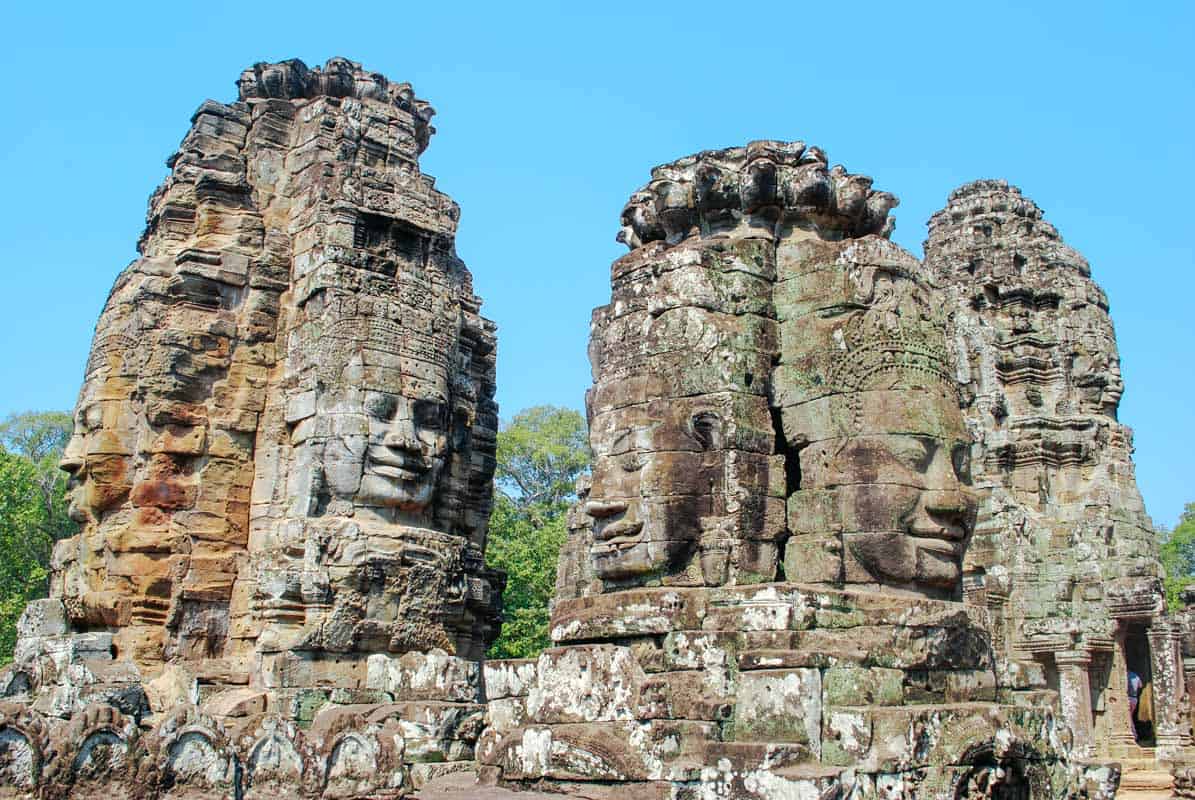


The Baphuon
Located in a short walk from Bayon, the Baphoun is another gorgeous temple worth visiting. Accessed via a long causeway, the temple has a pyramid shape featuring five levels and steep stairs. On the western side of the temple, you can hardly notice a 60-meter long reclining Buddha directly carved into the wall.

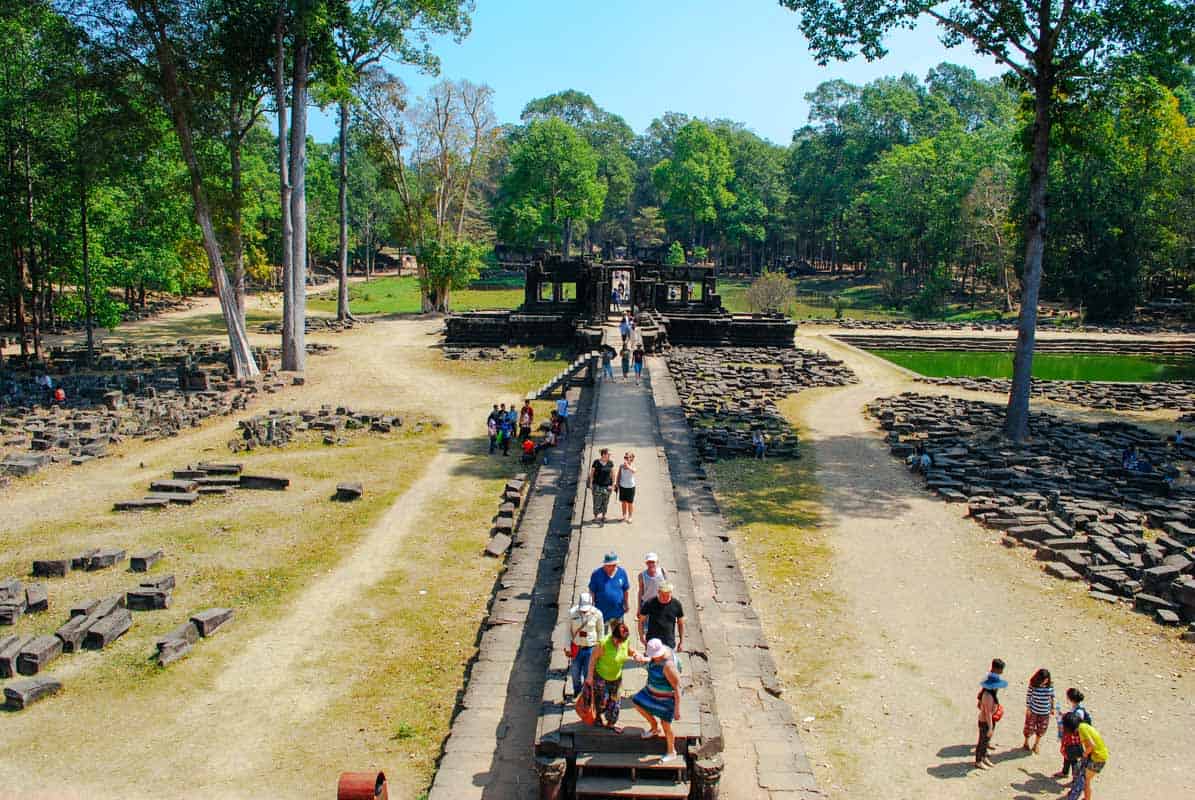
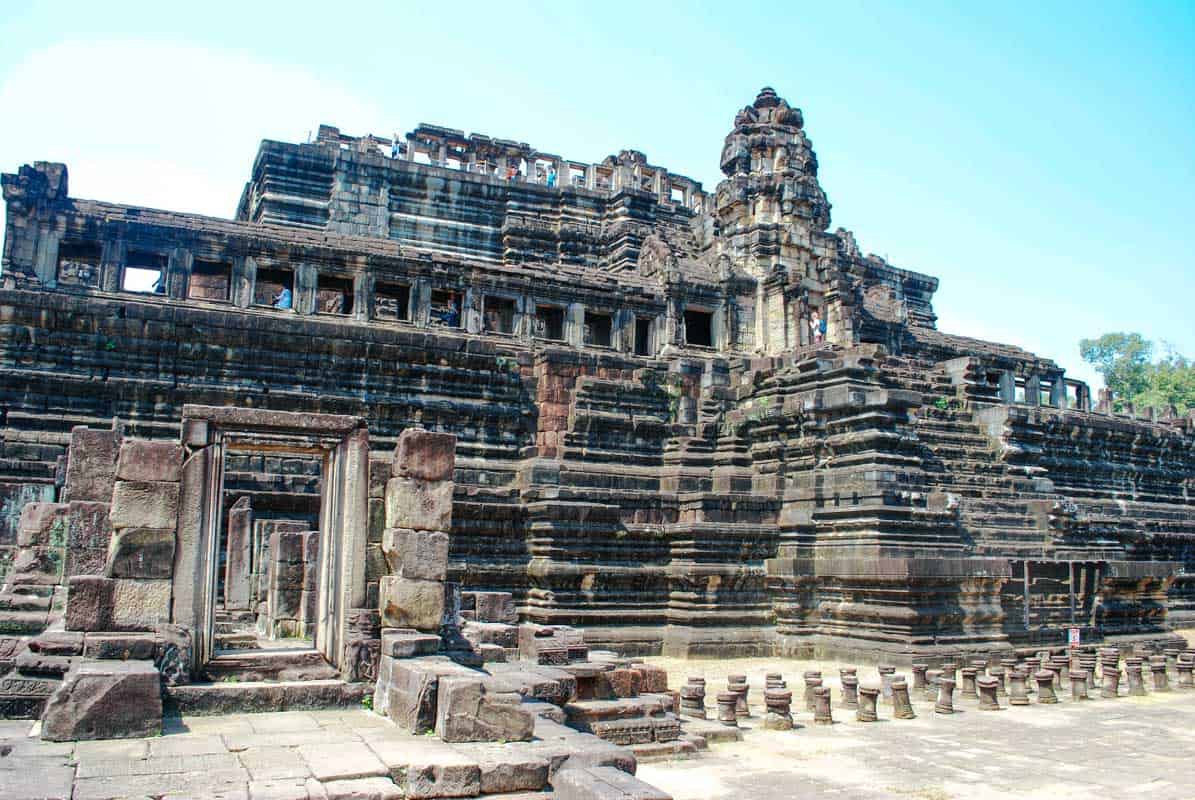
The Phimeanakas
This Hindu temple built in the 10th century is believed to have a golden spire or a dome. It has the shape of a three-tier pyramid that had a tower on top. Unfortunately, none of them remain today except the top platform used as a viewing point.
Terrace of the Elephants
The King used the terrace as a viewing platform to watch his army return. The clearly visible elephant carvings on the east side determined the name of the terrace. You don’t need much time exploring it, just make a short stopover.

Terrace of the Leper King
This terrace is also part of Angkor Thom built in the style of Bayon sitting very close to the Terrace of Elephants. The structure features bas-relief both inside and outside. There are several ideas surrounding the name and the purpose of the site. Some believe that it used to be a crematorium of royal family members with a statue of Yama, the God of Death, on top of the platform. Others think that the statue represents the god of wealth Kubera.
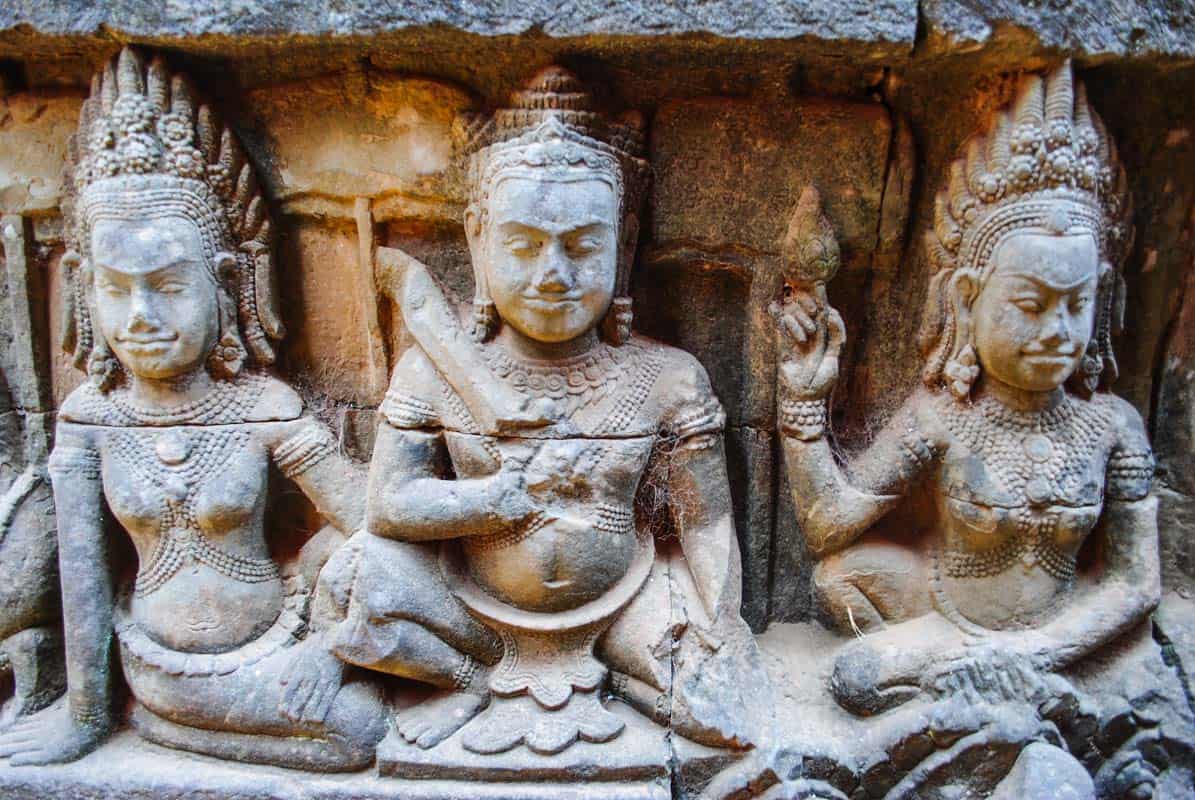

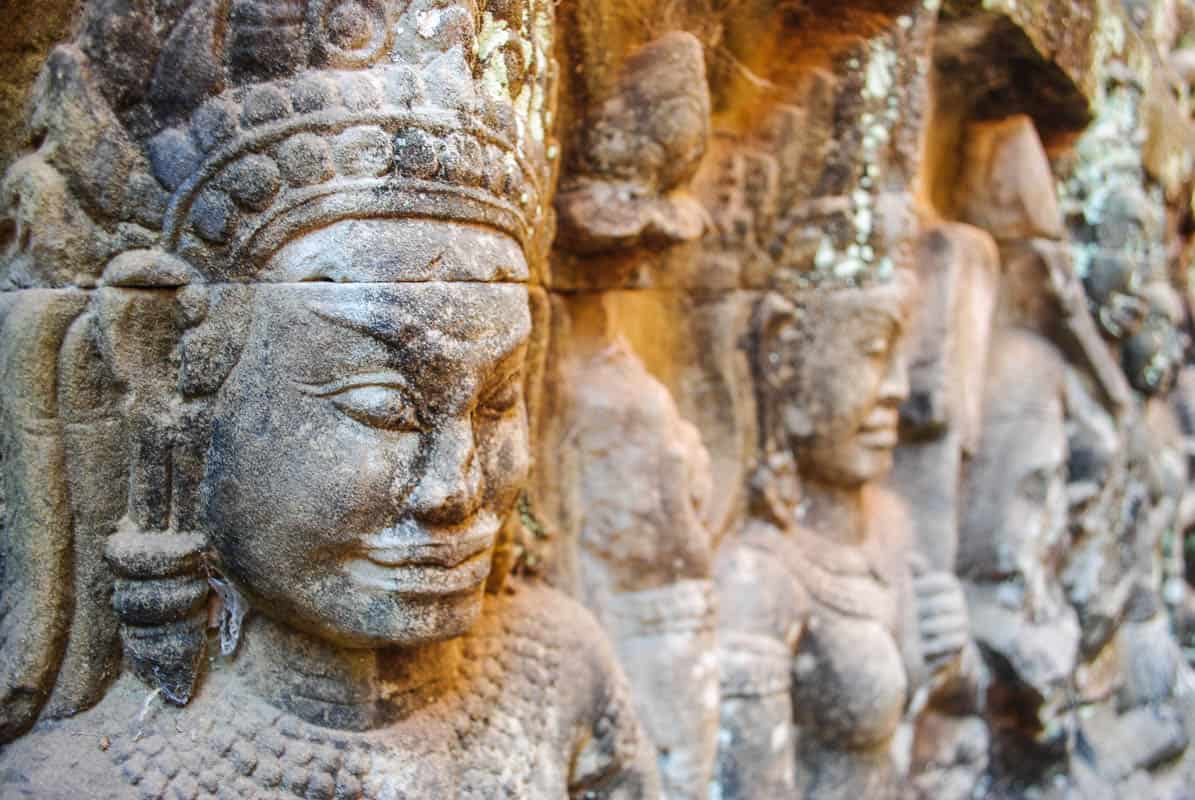
Ta Prohm
Ta Prohm is another popular spot and can’t be missed while visiting Angkor Wat. It is the filming location of the Tomb Raider I mentioned above. What makes this temple charming is not particularly the architecture, but the nature that took over and impacted the temple. Tree roots dominate the exterior and intertwine with the ruins, moss adheres to the stones, and leaves provide shade for the temples and the visitors. The entire area is turned into the hue of green and creating magical, yet a bit spooky, atmosphere.


Be a responsible traveler
Elephants
When visiting Angkor Wat temples, you’ll see several elephants offered as a ride to a sunset point. Be a responsible traveler and don’t ride them, because for an elephant to let someone ride needs to be brutally beaten. Moreover, they are over-worked in harsh conditions with almost no veterinary care. It could be a ‘one in a lifetime’ experience for you, but it means a lifetime of mystery for the animal. Additionally, riding animals is on the list of cruelest animal attractions of World Animal Protection, so don’t encourage the business by either riding, not taking photos.

Monkies
There are a number of monkies within the territory of Angkor Wat. While they are cute and all, don’t feed them. You may be kind to them by splitting your food, but it causes more harm than good, spreads disease, and helps to illegal hunting. Moreover, they become aggressive towards the tourists who spoiled them by feeding.
Be cautious of their existence and be aware of your belongings, especially if you have a bag of snacks or lunch. They will grab the bag and steal your food.
My favorite travel Resources
✈ Book affordable flights on Skyscanner, a platform that shows the best flight deals.
🚫 Get compensation for up to 700$ with Airhelp if your flight was canceled or delayed within the last 3 years.
🚗 Rent a car with DiscoverCars, a trusted international car rental website.
💻 Get a VPN from Surfshark to protect your devices from hackers when using public Wi-Fi when traveling.
📱 Install the Airalo app, which provides local eSIMs for a more affordable internet connection when traveling. Get 3 USD with code: BAIA2592.
💸 Use Wise to withdraw money in local currency without hidden fees and avoid high exchange rates. On top of that, you might get a Visa or Mastercard debit card.
🏨 Find budget-friendly deals on all sorts of accommodation types on Booking.com.
❣ Pre-book a private car transfer with Welcome Pickups to your hotel.
🩺 Buy the most flexible and budget-friendly travel insurance, SafetyWing, covering COVID with add-ons for adventure sports and electronics theft.
☀ Book in advance some of the best city walks, cultural experiences, and day tours to maximize your stay and experience here.

Want more inspiration?

Such a practical guide and I love your pictures! I can’t wait to see Angkor Wat for myself!
Wow! Lovely post. These temples are very fascinating and your pictures are simply amazing. Love the detailed description of each temple. I love exploring the ancient temples. Hope to visit this place some day! Thanks for sharing this interesting post. 🙂
I’m pretty sure Angkor Wat is on the list of everyone. After reading this post I am even more interested to visit. Beautiful photos!
After reading so much about Angkor wat and Siem reap it is pretty high on our list. We are amazed by its architecture and the intricate carvings around. Loved your pictures and detailed post.
Nice visitor guide to Angkor Archaeological Park! Just one remark, admission prices have increased since beginning of 2017. Now you pay US$ 37 for 1 day, US$ 62 for 3 days and US$ 72 for 7 days.